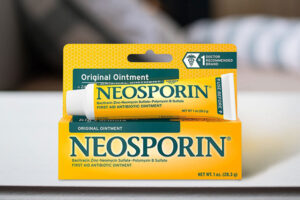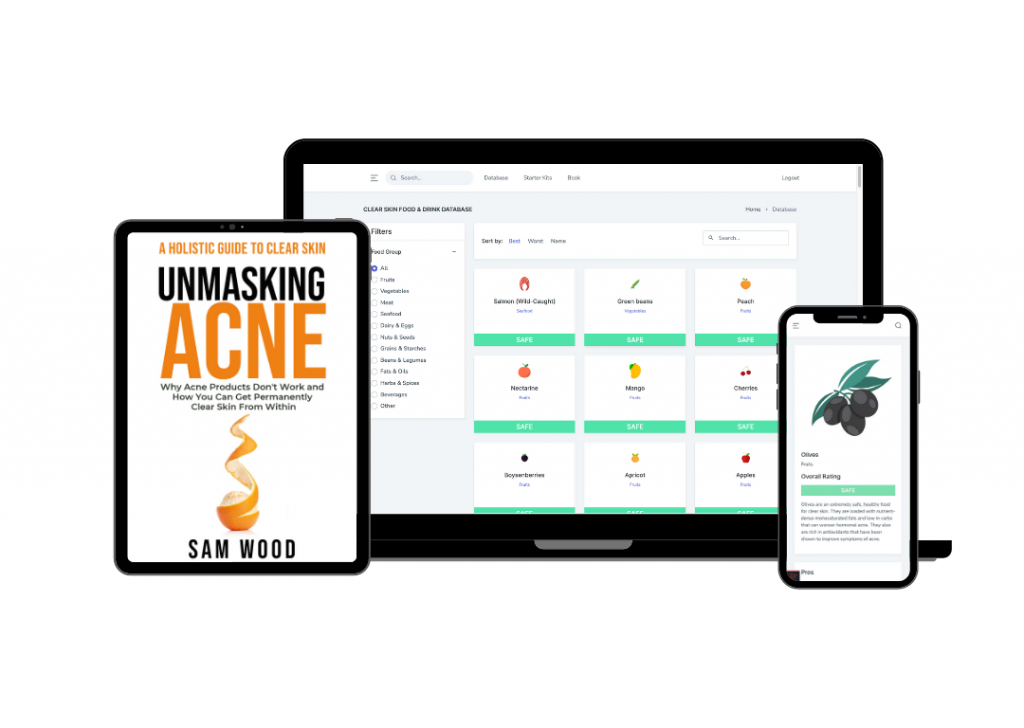Acne is one of the most common inflammatory skin conditions in the world, and it can be incredibly frustrating to deal with.
And while breakouts can occur for a variety of reasons, including hormones, lifestyle habits, and of course, food-related irregularities such as intolerances and allergies, we all know that the overgrowth of bacteria inside our pores is the final stage before pimples start to appear on the skin’s surface.
Which is why it makes sense for many of us to immediately reach for an antibiotic ointment like Neosporin whenever we see a pimple starting to form in an attempt to destroy the bacteria and keep our skin clear.
But with the many mixed reviews online, does Neosporin really help treat acne? Or some people that swear by it have just been incredibly lucky?
In this article, we will take a closer look at what Neosporin is, how it works, and whether or not it can help you get rid of your acne.
What is Neosporin?
Neosporin is the brand name of an over-the-counter ointment that’s commonly used on minor cuts, abrasions, and superficial wounds to prevent infections and promote healing.
The main active ingredients in this product are neomycin, bacitracin, and polymyxin, which are effective antibacterial agents that do the functional part in preventing environmental pathogens and bacteria from potentially entering the bloodstream through open wounds and causing serious infections.
Neosporin also contains other ingredients that help soothe and protect the skin, as well as soften rough and patchy areas caused by the injury. Some of these include petroleum jelly, cocoa butter, olive oil, and vitamin E, which is an excellent antioxidant with skin-healing properties that can also improve the appearance of scars and discoloration on the skin.
Can Neosporin Help Reduce Cystic Acne?
While Neosporin can help reduce redness and inflammation caused by acne, it’s important to understand that it’s not a cure for cystic acne.
Neosporin, as already mentioned above, is a medicated ointment that’s supposed to keep the skin’s surface clean and protected so that pathogenic bacteria don’t penetrate through open wounds and potentially cause an infection in our body.
The particular ingredient that does this is petroleum jelly, which is a heavy occlusive that creates a seal on the skin’s surface and protects the open wound underneath.
And while Neosporin contains antibacterial agents that keep harmful bacteria on the skin’s surface away from our open wounds, it doesn’t actually penetrate deep enough into the pores where the acne-causing bacteria C.acnes live.
This strain of bacteria feeds on hardened sebum mixed with dead skin cells and cellular debris stuck inside the pores and prefers an airless environment such as a clogged pore rather than the skin’s surface.
Therefore, Neosporin will likely not be effective in treating or preventing cystic acne that forms deep inside the pores; however, it might relieve some of the redness caused by acne.
But with that said, there is one case where Neosporin can be beneficial for acne, and that is when the cyst has already ruptured and the pus has come out, leaving an open wound.
In this case, Neosporin can help prevent infection and promote healing by creating a barrier on the skin’s surface and keeping harmful bacteria from our surroundings away from the vulnerable area.
Can Neosporin Help With Fungal Acne?
Fungal acne is a slightly different type of acne that occurs on the skin when there’s an overgrowth of the malassezia yeast.
This type of acne looks similar to regular acne; however, it’s often itchy and appears in clusters in oily parts of the face and body such as the forehead, cheeks, chest, and back.
Therefore, since this condition is technically caused by yeast and not bacteria, Neosporin will not be effective in treating or preventing fungal acne.
However, while Neosporin can help soothe some of the itchiness and inflammation that comes with fungal acne, using it can still be problematic because it contains occlusive ingredients that may clog the pores and lead to more breakouts.
Potential Side Effects of Using Neosporin for Acne
While Neosporin can be exceptionally effective in promoting healing as well as protecting wounds and ruptured skin from becoming infected, it’s still important to be aware of the potential side effects that come with using this medicated ointment.
Some common side effects of using Neosporin for acne include:
Clogging and Breakouts
As already mentioned before, Neosporin is a heavy occlusive due to the petroleum jelly and other emollients and oils it contains; therefore, using this ointment on your skin can actually cause you to break out even more.
Using it as a spot treatment might help an individual pimple heal here and there, but you shouldn’t rely on it as a treatment for acne in larger affected areas.
Redness and Inflammation
Due to the punch of active ingredients, Neosporin can cause the skin to become red and inflamed. While this might indicate a mild intolerance that will go away after the skin gets used to the medicated ointment, it could also be a sign of an allergic reaction, in which case you should definitely discontinue use.
Eczema
While Neosporin is often promoted as a product that can help relieve symptoms of eczema, using it on eczema-prone skin can actually make the condition worse in some cases.
This is because the strong antibacterial actives, particularly bacitracin, can be rather irritating for skin that’s already inflamed, and this particular ingredient has already been dubbed as a common cause of allergic contact dermatitis.
Rash
Rashes are a rarer yet more serious side effect of Neosporin that indicates the skin has come into contact with something it cannot tolerate.
This is your best sign that you’re either allergic to some of the ingredients or that you’re using too much of the product and should lower the frequency of use or the product’s strength.
Allergic Reaction
Allergic reactions can occur due to anything, and cosmetic products aren’t an exception.
An allergic reaction is your body’s way of telling you that it doesn’t like something and is trying to get rid of it by triggering the immune system into a histamine response.
Common symptoms of an allergic reaction include itchiness, redness, swelling, and in some cases, difficulty breathing.
Therefore, if you start noticing any of these discomforts after applying Neosporin on your skin, it’s best to immediately rinse it off and seek medical help if necessary.
Additionally, this also accentuates the importance of patch-testing before applying a product to a larger area of the body.
Therefore, if you are prone to allergies, you should definitely patch-test new cosmetic products on a smaller area to make sure you can tolerate them first.
Neosporin Alternatives for Acne
If you are having second thoughts about using Neosporin, but you are dealing with acne that needs immediate treatment, here are five other effective alternatives you can try:
Salicylic Acid
Salicylic acid is an ingredient that cuts through the superficial skin oil and travels deeper into the pores, where it dissolves the stiff clog made of dead skin cells, sebum, and cellular debris.
This will allow our natural oil to flow freely out of the pores instead of remaining stuck inside and serving as food for bacteria to grow.
Lastly, once starved, bacteria will then stop triggering the immune system into inflammatory reactions, and this will lead to pimples subsiding and eventually disappearing with consistent use.
Sulfur
Products that contain low-strength sulfur are another great option for reducing acne.
Sulfur is an antibacterial agent that helps neutralize the overgrowth of the acne-causing bacteria inside the pores and helps the skin recover from inflammation due to its naturally soothing and healing properties.
However, due to how well sulfur works, there’s always a risk of overuse, so it’s important to be mindful when using products that contain this ingredient, as overusing it can lead to irritation.
Niacinamide
Niacinamide is a vitamin that offers multiple benefits for the skin and actively works to reduce acne by balancing oil production and repairing the skin barrier.
And while having a healthy skin barrier might not sound like a primary concern when dealing with acne, it’s actually the main thing you should focus on, especially when trying to get rid of this inflammatory condition.
A healthy skin barrier means that the skin can better retain moisture and defend itself from inflammation and pathogens, including the overgrowth of bacteria.
Therefore, if you want clear skin, taking good care of your skin barrier is the number one thing you should pay attention to, and niacinamide is an ingredient that can help you do just that.
Benzoyl Peroxide
Benzoyl peroxide is an ingredient commonly found in cleansers and treatments for acne that works by releasing oxygen into the pores and destroying the airless environment acne-causing bacteria need to survive.
It’s highly effective against moderate to severe acne, and it’s loved by many due to its quick action.
With the proper use, benzoyl peroxide can significantly decrease acne after as little as several uses; however, due to its potency, it’s known to be drying to the skin, which is why it’s always best to start with lower percentages.
Retinoids
Retinoids are the most effective long-term treatment against acne.
They work by increasing cellular turnover, preventing dead skin cells from becoming stuck inside the pores and clogging them.
However, although retinoids are very effective, they can also irritate the skin, so it’s important to start with lower concentrations and increase the strength as your skin gets used to them.
Additionally, retinoids are notorious for making the skin more sensitive to sunlight, so it’s essential to always use acne-safe sunscreen when using products that contain any form of this active ingredient.
Mupirocin
Mupirocin is an antibiotic used to treat skin infections, including acne, folliculitis, impetigo, and general skin infections. Because Mupirocin is an antibiotic, a doctor’s prescription is required to buy it in the United States. If over-the-counter products cannot reduce acne breakouts or scarring, you should consult your doctor to see if Mupirocin could help alleviate your acne issues.

